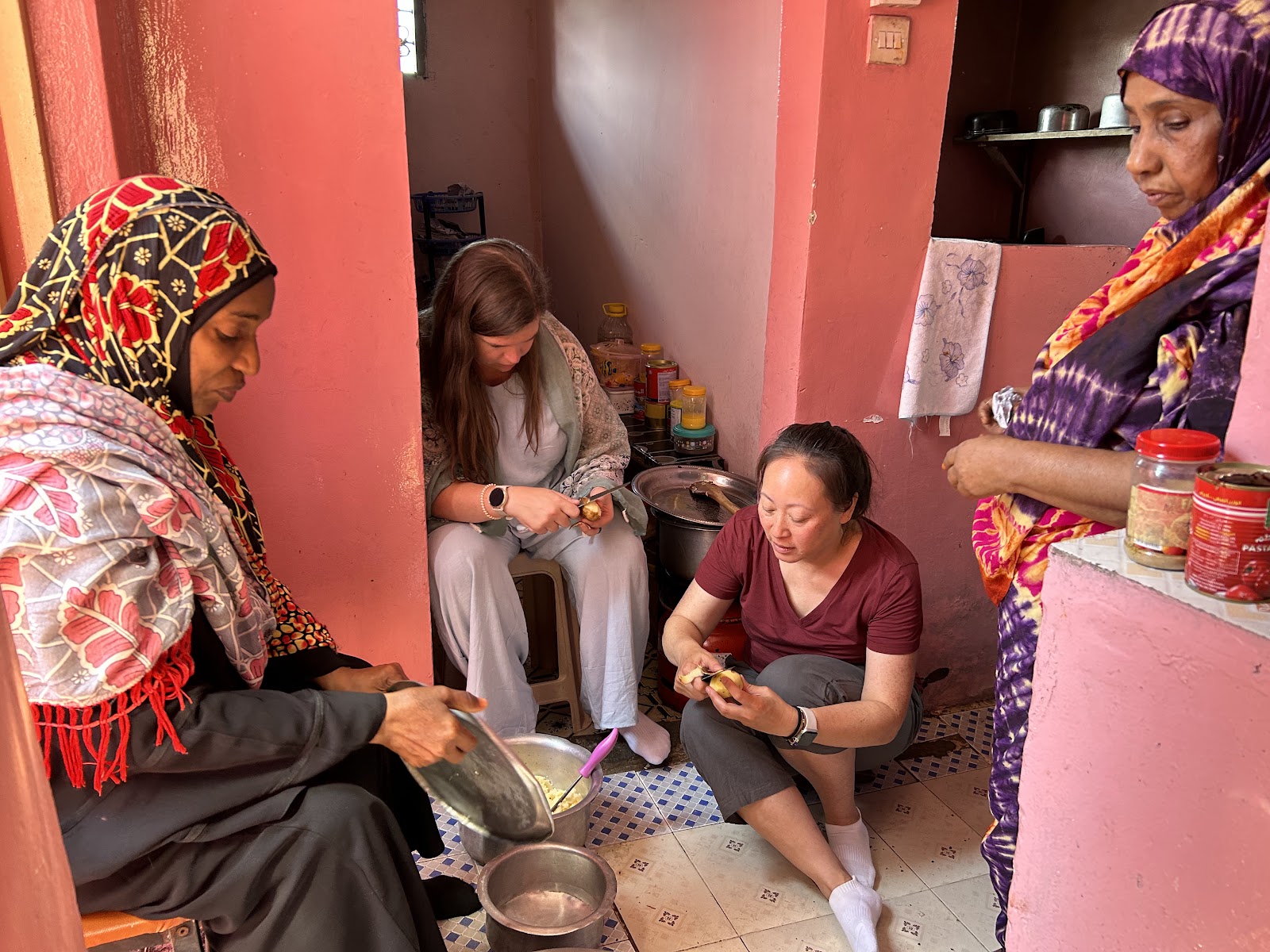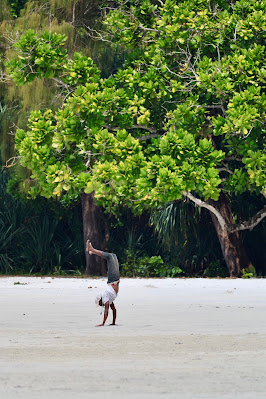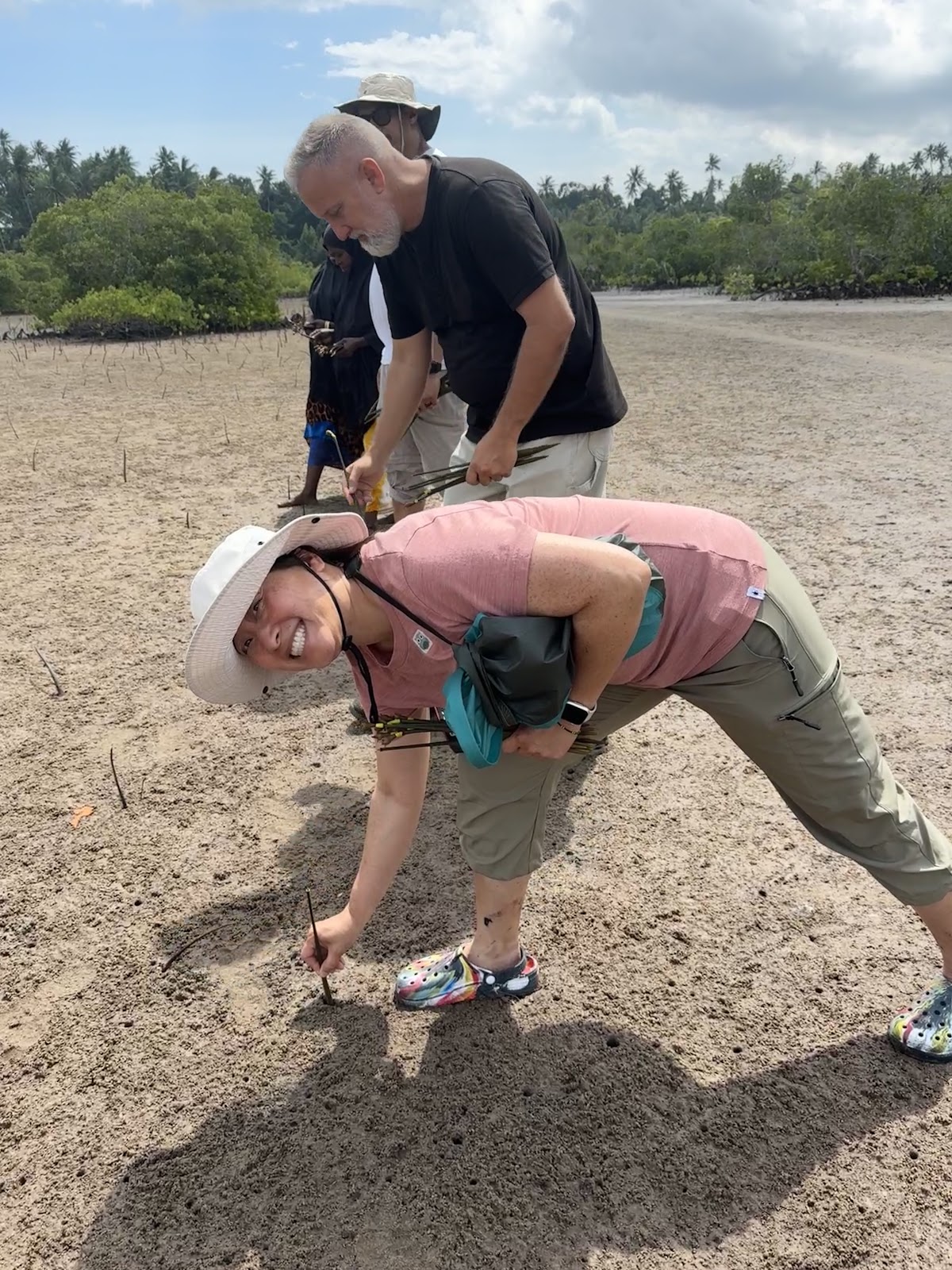CHAKE CHAKE, PEMBA ISLAND, ZANZIBAR
MONDAY, July 8
After an early morning meetup and a quick 20-minute flight, we transferred to Pemba Island – the second but much smaller of the two main Zanzibari islands. Pemba is more hilly and lush than Unguja. The waters around the two islands differ as well - lying closer to the mainland, Unguja sits on the continental shelf and is surrounded by relatively calm, shallow waters. It lends itself to safe and easier fishing and marine tourism, but it makes it susceptible to pollution and environmental degradation. Pemba, on the other hand, is close to the shelf's edge and has deeper water and stronger currents. It gets only a small fraction of Zanzibar's tourists, so I feel lucky to get to spend time here! |
| Exploring Pujini Ruins |
 |
| I wanted to put him in my pocket, but I refrained |
 |
| She's so pretty! (and he's so puny!) |
Nature has definitely taken back her dominance at Pujini; most of the fortress walls have eroded through time, and we could only just make out the basic foundation of the complex. In the overgrown ruins, we saw pied crow and sunbirds flitting around the trees. We also found a giant millipede and a large red-legged orb weaver (and her little teeny tiny mate!)
 |
| Playing with Snapchat filters |
After lunch we checked into the Pemba Island Hotel in downtown Chake Chake - Pemba's biggest city (with just one stoplight), and had our last Swahili lesson with Schwena. We spent some time on group reflections regarding our time so far, then had dinner (again made by Bibi Moza) on the roof of the PIH.
 |
| A marriage license is required for couples who want to share a room |
Our destination was the Ngezi-Vumawimbi Nature Forest Reserve where we learned about some of the challenges of forest conservation - not only is there illegal logging, but the local communities use the forest for traditional practices like using lumber to make charcoal.
 |
| The bleeding red mahogany tree |
 |
| It's just a constellation of stars! |
 |
| He looks just like a Haeckel's drawing! |
It was nice that we now have our afternoons free to relax, wander, and do some work, as many of us are exhausted (both from the time change and the relentless heat). When we got back to the hotel, Ann was on a mission to find bungo – the tart fruit that we’ve had in juice form for many days and that we all love. We wandered down to the local market, but it was towards the end of the day and many of the stalls were closing up. We wandered around a bit, which was nice since it felt like a true local experience – tourists rarely come to Pemba and we haven’t seen any other foreigners during our time here.
We ran into Rashid at the market across the street from our hotel, where we discovered our new favorite soda – apple punch. We also bought the stale popcorn on Rashid’s recommendation (it wasn't really that stale), as well as some fresh local dates that were delicious. It was nice getting to interact with the locals (and to practice our Kiswahili).
WEDNESDAY, July 10
 |
| The rice fields of Pemba |
 |
| Slogging through the sole-sucking mud. Get it? SOLE sucking?... |
 |
| 🦀 Craaaaaabs! 🦀 |
The exposed sand was absolutely crawling with fiddler crabs – it was fun to see them scurrying around, ducking into their holes. There were so many that it sometimes seemed as though the ground was alive! Did you know? Only the male fiddler crab has one giant claw - it can be up to half the crab's body weight!
Mangroves have uniquely adapted to the dramatically shifting water levels caused by the tides. Their seed pods are torpedo-shaped, with the bottom being heavier than the top. The pods begin to germinate on the tree, then drop when they are ready. If the tide is out, the spear-like pod will stick into the mud, quickly taking root within 4 hours. This way, they won’t get washed away by the incoming tides. Pods that don’t stick into the mud are washed away by the current, and some end up rooting in other places (thus dispersing the mangrove plants).
We each took a handful of seed pods and lined up to plant. We spaced ourselves a meter apart, and stabbed each propagule 3 inches into the mud, then took a large step and planted our next propagule. Although we didn’t spend much time planting, it was easy to see how a group effort could easily plant thousands of seeds in a planting session!
THURSDAY, July 11
Yesterday we learned about forests, and today we learned about agriculture and sustainable techniques for maximizing land use.
 |
| The sustainable "fertilizer factory" |
Interestingly, on the walk to the farm we passed a family making charcoal - the traditional fuel used by most homes in Zanzibar to cook their food. It's not environmentally sustainable but it is inexpensive, as most homes don't have the infrastructure for natural gas or electricity.
After lunch at a guest house in Wete (the second largest city on Pembe, and location of the only other stoplight on the island), we stopped to see a roost of the endemic Pemba flying fox. The roost we saw had HUNDREDS of individuals, and although the flying fox is normally a nocturnal animal, we were able to see a few flying around. Seriously, guys. IT WAS SO COOL!
With an entire morning free, I tried to sleep in (unsuccessfully – woke up at 3AM! 😭) but had a nice, leisurely breakfast. It was raining hard all morning, which kept the temperature (and bugs) down, and we decided despite the rain to venture out to see a spice farm. After all, we are on the Spice Islands! Ann, Allie, Rubin and I went to 1001 Organic Spice Farm and took a small walking tour through the small forest. We saw pretty much all the spices grown on the island: clove, ginger, cinnamon, turmeric, vanilla, pepper, ylang ylang, curry, cardamom, and other plants and fruit. Afterwards, we bought several packets of spice – I got cloves, cinnamon powder and sticks, and black peppercorns – all for 20,000 tsh. That afternoon, we received comfortable flowy dresses from Bibi Moza (known as Bimoza). We changed into them for our celebration with the local Pemba host moms, who normally house the SIT students during the semester. We danced to traditional Dufu music (full of drums and chanting) and had a lovely time dancing with the moms.
That evening, we had a quick transition to the Pemba airport, a 20 minute flight to Unguja to pick up more passengers, then a 15 minute flight to Dar Es Salaam – the largest city in Tanzania. It was raining when we arrived, and a jarring transition from the quiet island life of Pemba to the huge metropolis that is Dar. Traffic – particularly in the rain – was horrendous, and it was past 9PM when we finally arrived at the mega-mall near our hotel where we would grab dinner. (btw, walking through the mall was such a culture shock after the peaceful, rural existence on Pemba. Our eyes were huge and mouths agape, as though we hadn’t seen civilization in months rather than just a few days. Such dichotomy is truly jarring!)






















No comments:
Post a Comment